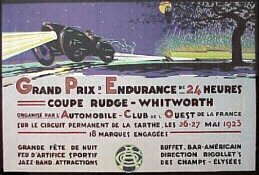Les 24 Heures du Mans
Poster of the first 24 Heures du Mans in 1923. Image credit: Automobile Club de l'Ouest, Public domain, via Wikimedia Commons
This month, the oldest automobile endurance race still in operation kicks off its second century about 200 kilometers southwest of Paris, France. First run in Le Mans in 1923, the 24 Heures du Mans (24 Hours of Le Mans) is won by the team that goes the furthest distance in 24 hours rather than covering a set distance like the Indianapolis 500 and Monaco Grand Prix, the other two races that make up the unofficial Triple Crown of Motorsport. The challenges presented by the 24 Heures du Mans have led to global renown for victorious drivers and technological developments for vehicles, engines, and parts that benefit consumer and commercial vehicles.
The Automobile Club de l’Ouest (ACO) organizes the 24 Heures du Mans and other road events and conducts programs and events for motorsport enthusiasts. By designing a race that measures time instead of distance, Le Mans requires participants to balance speed, fuel-efficiency, and reliability through design and engineering. The race is held each June under warm and sometimes wet and rainy conditions, requiring endurance and skill from competitors as well as durability with respect to tires, brakes, and other vehicle elements that are placed under great strain during the race. Approximately 60 entries each year compete for the overall title as well as prizes for classes with different vehicle specifications. Each team must have a minimum of three drivers who are limited to a shift maximum of 4 hours and a total driving time of 14 hours. During refueling stops cars must be turned off and driver exchanges can take place yet race rules prevent mechanics from working on the vehicles during these stops, placing reliability at an even higher premium than in fixed-distance races. Today, driving teams regularly surpass 5,000 km / 3,000 miles during the entire race time.
Flyover at Le Mans with the tricolor of France. Image credit: United Autosports, CC BY-SA 2.0, via Wikimedia Commons
Additional stress and skill come into play on the race course which includes sharp turns as well as the famed Ligne droite des Hunaudières which is called the Mulsanne Straight in English. This 6-km stretch of public road bears the effects of regular car and truck traffic that cause it to vary considerably from the pavement maintained by dedicated racetracks and its difficulties are compounded by the changing light and darkness over the course of 24 hours. When rain falls during a race, wet road conditions and impaired visibility add to the challenges. It is on this stretch that the speed record of 253 mph (407 km/h) was set by Roger Dorchy in 1988, but also the site of numerous fatal accidents. In 1990, the Fédération Internationale de l’Automobile (FIA) decided that the maximum length of a straight would be set at 2km. Two chicanes, or bump-out curves, were added to the Mulsanne Straight to comply with this ruling; however, some drivers continue to attain maximum speeds of 200 mph during les 24 Heures du Mans.
The Le Mans Hypercar debuted in 2021 to replace the Le Mans Prototype 1 (LMP1) as the highest-level class. Its regulations were jointly determined by the ACO and FIA. Commercial manufacturers such as BMW, Cadillac, Ferrari, and Porsche and specialty automotive companies such as Glickenhaus have dedicated groups that design and build racecars within Hypercar regulations. The next class of Le Mans Prototype (LMP2) cars must use a specific engine and select from an official list of four chassis whereas the third class, Le Mans Grand Touring 3 (LMGT3), allows for greater variation from mass-produced car models within a different set of technical regulations. Each year a concept car also participates in les 24 Heures du Mans to test and display technological innovations under the Garage 56 designation.
Peugeot 905 from 1993. Image credit: Nuvolari72, Public domain, via Wikimedia Commons
Le Mans winners have mostly been European, with 9-time champion Danish driver Tom Kristensen (1997, 2000-2005, 2008, 2013) topping the list and earning the nickname ‘Mr. Le Mans’. He broke the previous record of six Le Mans titles held by legendary Formula One driver Jacky Ickx of Belgium, who had won in 1969, 1975-77, 1981, and 1982. A trio of five-time winners include Briton Derek Bell, Frank Biela of Germany, and Emanuele Pirro of Italy. Similarly, European manufacturers have been the most successful at Le Mans, with Porsche, Audi, Ferrari, Jaguar, and Bentley racking up the most wins over the first century of Le Mans. The future holds a wider pool of viable competitors as shown by the success of Toyota Gazoo Racing of Japan who fielded the champion team comprised of Japanese, Argentine, British, New Zealand, Spanish, and Swiss drivers from 2018-2022.
Les 24 Heures du Mans 2024 will take place from Saturday afternoon (in France) through Sunday this weekend after nearly a week of initial inspections, training and qualifying runs, and associated activities such as go-karting and the Fun Cup of competing Volkswagen Beetle cars. About 250,000 spectators will converge in Le Mans and the race will be broadcast worldwide. Ferrari intends to defend its 2023 title, Porsche is seeking a record 20th victory, yet a BMW team posted the fastest qualifying time. With less than one second separating the top eight qualifiers, no single team is a clear favorite to win.
Activité de français
This is not a scenic drive through the French countryside! Participate vicariously in the video below that provides a cockpit view of the 24 Heures du Mans Circuit during a test drive with Loïc Duval in a Peugeot 9x8 2024.
Subscribe to our newsletter to receive Art de vivre posts, information about courses, Conversation Café, special events, and other news from l’Institut français d’Oak Park.




